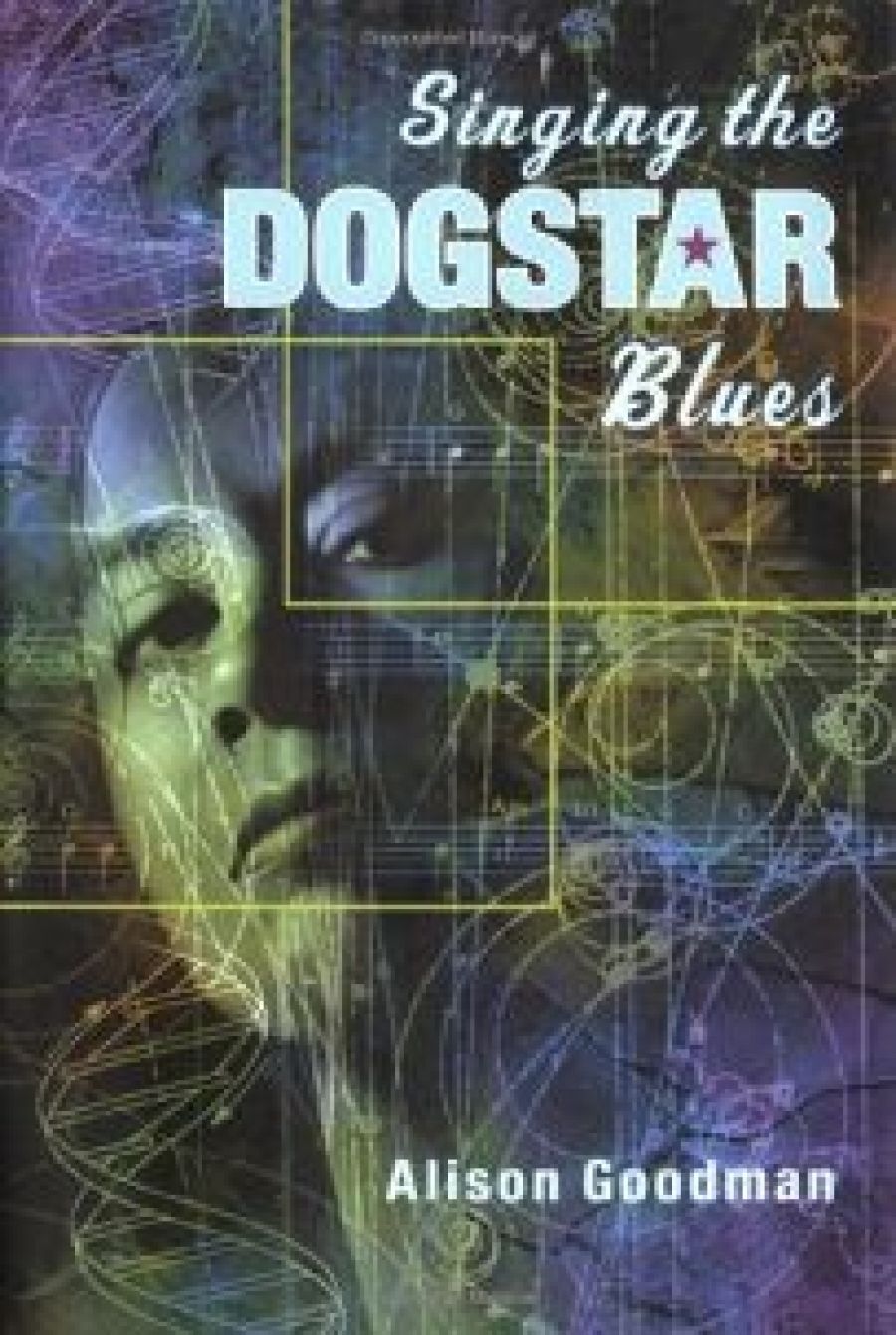
- Free Article: No
- Contents Category: Young Adult Fiction
- Review Article: Yes
- Online Only: No
- Custom Highlight Text:
Readers of science fiction tend to discover the genre during their early teens, which should make sf an ideal sub-genre of Young Adult fiction. But the mainstay of the Young Adults genre, as it has developed over the last thirty years, is the novel of family relationships. Science fiction writers are often uncomfortable with personal relationships. The stars are their destination, not the living room; transcendence is the game, not emotional sustenance.
- Book 1 Title: Singing the Dogstar Blues
- Book 1 Biblio: HarperCollins, $12.95 pb, 200 pp
- Book 1 Readings Link: booktopia.kh4ffx.net/kjPDnd
It’s refreshing then to read Alison Goodman’s Singing the Dogstar Blues, which demonstrates its author’s familiarity with both science fiction and Young Adult fiction and her ability to achieve originality in both genres.
On the surface, Singing the Dogstar Blues is a compendium of familiar science fiction ideas. She shows us Melbourne in the middle of the next century. Non-threatening aliens (The Chorians) have landed on earth, wanting to trade technologies. They offer instantaneous space travel. Melbourne offers time-travel, developed by the Sunawa-Harrod Centre of Neo-Historical Studies.
Goodman does not waste space drawing laborious pictures of this near-future society. Sketches are more interesting; these sketches are provided by Joss Aaronson, the book’s seventeen (nearly eighteen)-year old storyteller. Joss is sitting in the Buzz Bar, centre of her social underworld. The conversation with the barman and his son reveals much about the stratified social structure of Goodman’s future Australia, tells of Joss’ uncomfortable relationship with her mother Ingrid and begins the story of Joss’ career as a time jumper.
Joss has been accepted as one of the twelve students of the Centre of Neo-Historical Studies who will be trained to become time jumpers. She faces career problems, especially Professor Joseph Camden-Stone, head of the Centre. For reasons unknown, he wants Joss to fail the course and leave the Centre. Time jumpers train in pairs. Joss is selected as a partner by Mavkel, the first Chorian to take the course, so Camden-Stone is forced to let her stay.
Joss is a ‘comp’ (composite), tomorrow’s equivalent of today’s test-tube babies. Fifty years from now there will be large numbers of comps, treated by many as a subclass within
society. Joss does not know the name of her sperm-donor ‘father’. Her rich mother sends her money and otherwise ignores her most of the time. Sardonic and freewheeling though she likes to appear, Joss knows that her position in this future society is very vulnerable.
The complications of Joss’ family background are not merely bits of characterisation, but are central to the practical problems of becoming a time jumper. Mavkel, whose hermaphroditic partner Kelmarv has been killed, needs to bond with Joss at a telepathic level before the new partnership can work. This cannot happen until ‘bloodlines’ are established: Joss must find out who her father was, although all official records of his name have long since been erased. At the same time she needs to find out why she is being followed by two threatening types, a muscly mystery man, and Tori Suka, a well-known professional assassin.
Usually Joss would have to survive two years of training before being allowed to time jump. The urgent need to travel backwards eighteen years to find out her father’s name impels her and her friends to hijack a time machine. Goodman is particularly good at putting the reader through the experience of time travel, travelling to a place that is familiar but in which everything is suddenly unfamiliar.
Family problems are as pressing as time travel problems. From Joss’s viewpoint, her mother Ingrid is a cold careerist, who sends presents rather than turning up for her daughter’s birthday. But Ingrid’s ex-partner Louise, who meets Joss for her eighteenth birthday, tells her that Ingrid has always been afraid of Joss. ‘Isn’t it time,’ she asks, ‘you saw your mother as a real person instead of Godzilla?’
Mavkel becomes part of Joss’ life in uncomfortable and hilarious ways. Joss’ one consolation in life is playing twentieth-century blues on the mouth harp. To Mavkel, human music is deeply disturbing. On Choria, it is used only for healing. Mavkel wants to stay physically close to his new partner because he cannot ‘talk’ to her telepathically. Joss, ever the loner, has great difficulty with this closeness.
The tense and superbly managed mystery story is one of the book’s strengths. The other is Joss’ voice. Time and again, she will relate a bit of the story, only to sum up the situation with a deft phrase or piece of future slang. The Chorians have voices ‘kind of like Billie Holiday with a cold’. When Mavkel is moved to embrace her ‘it was like being kissed by a mild-mannered vacuum cleaner’.
Singing the Dogstar Blues is a mystery story, a thriller, and a family drama, told in a vivid, sardonic, constantly hilarious style that swings the reader straight into the middle of this future society without distracting us with uncomfortable lumps of science fictional explanations. It is an exhilarating novel that escapes the limitation of genre.


Comments powered by CComment